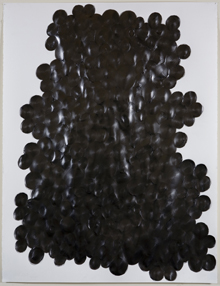
A PLAYFUL NOTE “Drawing #13,” graphite on paper by James Marshall. |
In “Drawing,” the spare, residential Icon gallery offers the work of 13 Maine artists on intimate display. With one exception, two works are displayed by each artist; some of the most interesting insights can be found in the conversation between pieces. Many of these works have been exhibited before, and “Drawing” has the complexity and depth of a real artists’ art show, a studious conference on the medium of line drawing.Astrid Bowlby’s black ink-on-paper renderings seem to aim for a clean and impenetrable blackness. Beginning the exhibition here, the viewer is asked to undergo an incomprehensible task, starting with a palette of complete opacity.
An enormous untitled graphite piece by Kate Beck cuts through the darkness. A selection from her “Whitespot” exhibition last year at Icon, the work of Beck’s hand consists of parallel graphite lines at varying depths and intensities over a white, empty space. The thin parallels collect and swell at points into deep fault lines, establishing a rhythm like a Steve Reich counterpoint. The careful, precise objectification of emptiness is one of Beck’s hallmarks, and the intricacy of this piece upholds it.
James Marshall’s “Drawing #13” adds a playful note to the gallery’s fugue. Composed of an overlapping cluster of tightly coiled cymbals of graphite on paper, “Drawing #13” achieves a sculptural three-dimensionality when viewed in the gallery, giving it the illusion of a contour found in a monstrous weld.
Two works by Noriko Sakanishi echo the musicality of Kate Beck’s “untitled.” In “Tipping Point” and “Honest Response” (graphite and ink on paper), five values of gray pepper the grid in a seemingly arbitrary language. Like a monochromatic Mondrian, the serial structure and form of Sakanishi’s work seems both codified and strongly informed by music, and her pieces here serve as swatches for the more realized work in her “Elements” exhibition at the June Fitzpatrick Gallery.
In the upstairs gallery, two ink-on-paper works from Frederick Lynch’s “Division” series continue the theme of systematic and rigorous repetition. Architectural and kaleidoscopic, Lynch’s works appear devoted to an arduous algebraic structure. The arches and doorways that emerge in “Division Drawing #10” are sectored and factored down to their smallest workable iterations, creating a pattern of archeological footprints.
Amparo Hufschmid breaks the serial mold with two works of graphite and beeswax on paper and panel. Named after a serene region of Maryland, “St. Mary’s County #26” depicts a semblance of dark graphite foreground before a bleak encaustic backdrop. Though a stark contrast to the intense linearity of Beck, Lynch, and Sakanishi, Hufschmid’s works are as grim and memorable as anything else in the exhibition.
Two works by Peter Bennett from “The Artist” series each depict a bizarrely armored figure in a comic-book universe style, mechanized and festooned with indistinguishable, slightly animated tools. While “The Artist #9” appears aided by his body’s artillery, “The Artist #10” appears more embattled, as if hampered by his own capabilities.
“Stairs Made With Windows” is a signature Joe Kievitt piece, with “windows” of bright plaid textiles weaving symmetrically over a white backdrop. The intrepid pattern converges confidently in the center of the drawing, forming a response to the achromatic drawings downstairs, which can seem to dissipate off the canvas. A second piece, “untitled,” maintains the tone in thick, churning coronas of gray plaids.